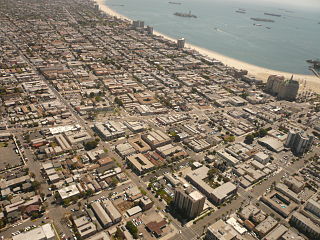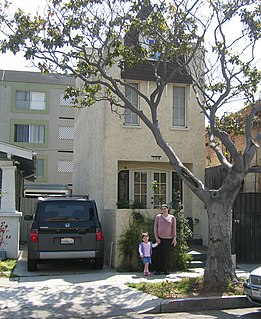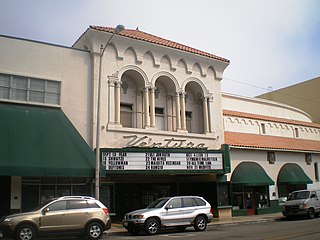El Camino College is a two-year public community college located in the unincorporated area of Los Angeles County known as Alondra Park. It consists of 37 buildings spanning an area of roughly 26 acres (11 ha). It is one of two community colleges serving Southern California's South Bay area.

Downtown Long Beach is the heart of Long Beach, California, United States, and is the location for most of the city's major tourist attractions and municipal services. It is also the location for numerous businesses. There are many hotels and restaurants in the area that serve locals, tourists, and convention visitors.

The Bay Theatre is a single-screen movie theater in Seal Beach, California, in the United States of America. It is best known for its screenings of foreign and independent films, and for its revival screenings. The Bay Theatre is also home to a Wurlitzer organ which is used for concerts and silent film screenings.

The House of the Temple is a Masonic temple in Washington, D.C., United States that serves as the headquarters of the Scottish Rite of Freemasonry, Southern Jurisdiction, U.S.A.

California's 46th congressional district is a congressional district in the U.S. state of California.

The Detroit Masonic Temple is the world's largest Masonic Temple. Located in the Cass Corridor of Detroit, Michigan, at 500 Temple Street, the building serves as a home to various masonic organizations including the York Rite Sovereign College of North America. The building contains a variety of public spaces including three theaters, three ballrooms and banquet halls, and a 160 by 100 feet clear-span drill hall.

Rancho San Pedro was one of the first California land grants and the first to win a patent from the United States. The Spanish Crown granted the 75,000 acres (300 km2) of land to soldier Juan José Domínguez in 1784, with his descendants validating their legal claim with the Mexican government at 48,000 acres (190 km2) in 1828, and later maintaining their legal claim through a United States patent validating 43,119 acres (174.50 km2) in 1858. The original Spanish land grant included what today consists of the Pacific coast cities of Los Angeles harbor, San Pedro, the Palos Verdes peninsula, Torrance, Redondo Beach, Hermosa Beach, and Manhattan Beach, and east to the Los Angeles River, including the cities of Lomita, Gardena, Harbor City, Wilmington, Carson, Compton, and western portions of Long Beach and Paramount.

Los Cerritos Ranch House, also known as Rancho Los Cerritos or Casa de los Cerritos, in Long Beach, California, was "the largest and most impressive adobe residence erected in southern California during the Mexican period". Los Cerritos means "the little hills" in English. It was declared a National Historic Landmark in 1970.

The former Second Church of Christ, Scientist, located at 655 Cedar Avenue, in Long Beach, California, is an historic structure that on April 1, 2005, was added to the National Register of Historic Places. It is now the Second Samoan Church.

Alamitos Beach is a coastal neighborhood in the southern portion of the city of Long Beach, California. Although it was in unincorporated Los Angeles County when annexed by the City of Long Beach, it had been planned as its own community with a townsite.

The aptly nicknamed Skinny House at 708 Gladys Avenue in the Rose Park neighborhood of Long Beach, California, United States, is a narrow three-story house that has been cited by both the Guinness Book of World Records and Ripley's Believe It or Not as the nation's skinniest house.
Rancho Los Cerritos was a 27,054-acre (109.48 km2) 1834 land grant in present-day southern Los Angeles County and Orange County, California The grant was the result of a partition of the Rancho Los Nietos grant. "Cerritos" means "little hills" in Spanish. The rancho lands include the present-day cities of Cerritos and Long Beach.
The former First Church of Christ, Scientist is a historic Christian Science church building located at 440 Elm Avenue, Long Beach, California, United States. Built in 1913, it was designed in the Classical Revival-style of architecture by noted Los Angeles architect Elmer Grey.

The Insurance Exchange Building, formerly known as the Middough Building and the Middough Brothers Building, is a registered historic building located on Broadway in downtown Long Beach, California, USA. The eight-story Beaux Arts building was one of the largest office buildings in downtown Long Beach when it opened in 1925. The building was added to the National Register of Historic Places in 2003.

Scottish Rite Cathedral in Long Beach, California, is a Long Beach Historic Landmark. It is a five-story Romanesque Revival structure built for the local Scottish Rite branch of Freemasonry. It was declared a historic landmark in 1980.

Frederick Heath was an American architect responsible for numerous projects in Tacoma, Washington. He worked out of his own office and as a senior partner at architectural firms. He was involved with Spaulding, Russell & Heath, and Heath & Gove. His work included designs for several historic and notable schools, churches, stadiums, and commercial properties.

The Long Beach Marine Stadium is a marine venue located in Long Beach, California. Created in 1932 to host the rowing events for the 1932 Summer Olympics in neighboring Los Angeles, the stadium was the first manmade rowing course in the United States. The venue also hosted the United States rowing trials for the 1968 Summer Olympics that were held in Mexico City.

The Ventura Theatre is a historic live concert venue in downtown Ventura, California. This was "the only luxury theatre built in Ventura County in the 1920s in the "style of the great movie palaces." The lavish, elegant interior of gilt and opulence was originally designed by Robert E. Power Studios of San Francisco and has been restored. The theatre with a capacity of 1,150 and a flanking office building were designed by architect L. A. Smith in the Spanish Colonial Revival architecture that was favored by architects of motion picture theaters during the 1920s.
















